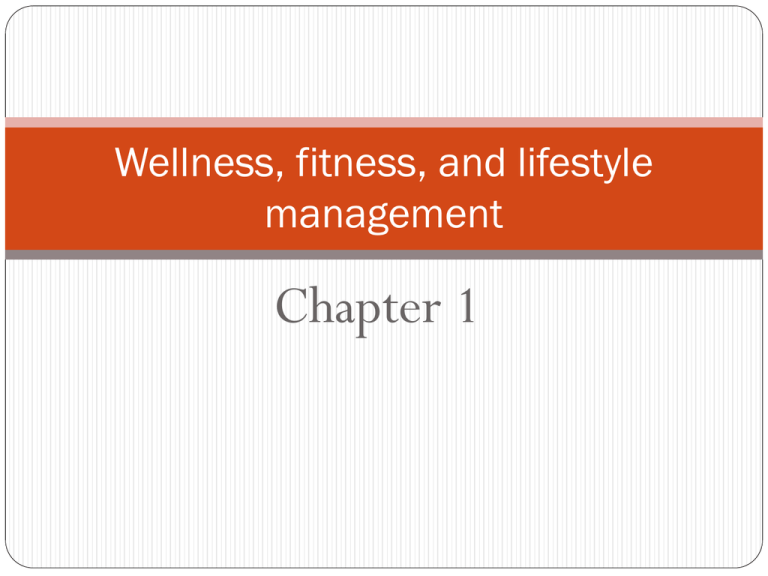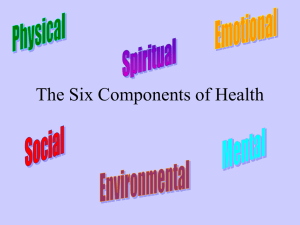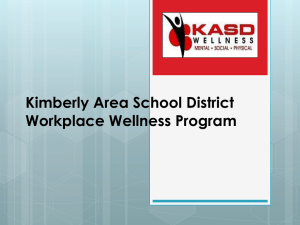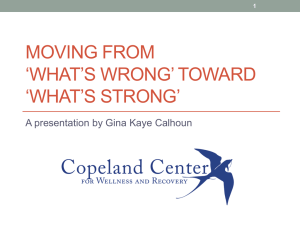Wellness, fitness, and lifestyle management - Ch 1
advertisement

Wellness, fitness, and lifestyle management Chapter 1 Test your knowledge 1. Which of the following lifestyle factors is the leading preventable cause of death for Americans? a. excess alcohol consumption b. cigarette smoking c. obesity b. Smoking causes about 500,000 deaths per year; obesity is responsible for more than 100,000; and alcohol, as many as 85,000. 2. The terms health and wellness mean the same thing. True or false? FALSE. Although the words are used interchangeably, they actually have different meanings. The term health refers to the overall condition of the body or mind and to the presence or absence of illness or injury. The term wellness refers to optimal health and vitality, encompassing six dimensions of well-being 3. Which of the following health-related issues affects the greatest number of college students each year? a. stress b. colds/fl u/sore throat c. sleep problems d. concern for a friend or family member a. About 32% of college students suffer so much stress that it affects their academic performance. High stress levels affect overall health and wellness, making it important to learn effective stress-management techniques HEALTH vs WELLNESS Health: Absence of illness or injury Influenced by factors beyond your control: genes, age, family history Wellness Determined by your own decisions about your life Involves making conscious decisions to control risk factors: eating sensibly, exercising, having regular screening tests. The 6 dimensions of wellness Physical: your body’s overall condition, fitness level, and your ability to take care of yourself. Emotional wellness:Your ability to understand and deal with your feelings. Intellectual: your ability to challenge your mind, seek out new experiences and challenges. Social – Interpersonal:Your ability to develop and maintain satisfying and supportive relationships. Spiritual: Set of guiding beliefs, principles and values that give meaning and purpose to your life. Environmental – vocational – occupational: livability of your surroundings. Your personal health depends on the health of your surroundings and your planet. The wellness continuum Low levels of wellness High levels of wellness Physical, mental, emotional symptoms Change and growth Lab 1. Your Wellness Profile pg 23 Consider how your lifestyle, attitudes, and characteristics relate to each of the six dimensions of wellness. Fill in your strengths for each dimension. Use the examples provided to guide you. Once you’ve completed your lists, choose what you believe are your five most important strengths, and circle them. Next, think about where you fall on the wellness continuum for each of the dimensions of wellness. Indicate your placement for each – physical, emotional, intellectual, spiritual, interpersonal/social, and environmental – by placing Xs on the continuum below. Complete the rest of the lab and find out about your level of wellness. New opportunities, new responsibilities Before 1900 Infectious diseases Poor environmental conditions After 1900 Chronic diseases Lifestyle choices and behaviors o Smoking o Diet o Inactive lifestyle o Alcohol use Leading causes of death US. o Heart disease o Cancer o Stroke o Chronic lower respiratory disease o Unintentional injuries What is being done? National Healthy People Initiative National goals Prevent disease Increase quality and years of healthy life Eliminate health disparities among Americans. Objectives Estimate of Current Status (%) Goal (%) Increase the proportion of people age 18 and older who engage regularly in moderate physical activity. Increase the proportion of people age 2 and older who consume at least 3 daily servings of vegetables, with at least one-third being dark-green or orange vegetables. Increase the prevalence of healthy weight among people age 20 and older. Reduce the proportion of adults 18 and older who use cigarettes. Reduce the proportion of college students reporting binge drinking during the past 2 weeks. Increase the proportion of adults who take protective measures to reduce the risk of skin cancer (sunscreens, sun-protective clothing, and so on). Increase the use of safety belts by motor vehicle occupants. Increase the number of residences with a functioning smoke alarm on every floor. Increase the proportion of persons with health insurance. 30 50 3 32 21 39 50 60 12 20 71 82 90 84 85 92 100 100 Behaviors that contribute to wellness Be physically active Choose a healthy diet Maintain a healthy body weight Manage stress effectively Avoid tobacco and drug use and limit alcohol consumption Protect yourself from disease and injury Take other step toward wellness Lab 2. Lifestyle evaluation How does your current lifestyle compare with the lifestyle recommended for wellness? For each question, choose the answer that best describes your behavior; then add up your score for each section. Reaching wellness through lifestyle management. Getting serious about your health Examine your current health status Choose a target behavior Find help Build motivation towards change Examine the pros and cons of change Boost self efficacy, believe in your ability to succeed Find a locus of control, take control of your life. Use visualization and self talk: visualize yourself enjoying the benefits of your lifestyle change. Identify and overcome barriers to change Moving forward in the cycle of behavior change Pre-contemplation: you don’t think you have a problem and don’t intent to change your lifestyle. Raise your awareness Be self aware Seek social support Identify helpful resources Contemplation: you know you have a problem and intend to take action within 6 months Keep a journal Do a cost – benefit analysis Identify barriers to change Engage your emotions Create a new self-image Think before you act Moving forward in the cycle of behavior change Preparation: you plant to take action within a month or may already begun to make small changes in your lifestyle. Create a plan Make change a priority Practice visualization and self-talk Take short steps Action: you modify your behavior and environment. You are at risk of reverting that behavior. Monitor your progress Change your environment Find alternatives to your target behavior Reward yourself Involve your friends Don’t get discouraged Deal with relapse Moving forward in the cycle of behavior change Termination: you have succeeded in changing your lifestyle. Keep going Be prepared for lapses Be a role model Creating a plan Monitor your behavior and gather data 1. Keep a journal Record every occurrence of your behavior What was the activity When and where it happened What were you doing How you felt at that time Analyze the Data and Identify Patterns 2. Note relations between your feelings and external factors: day, location, situation, influences. Creating a plan 3. Be “smart” about setting goals Your behavior changes should be Specific Measurable Attainable Realistic Time frame – specific As you work toward meeting your long term goal, you may find it necessary to adjust your short term goals. Creating a plan Device a plan of action 4. Get what you need Modify your environment Control related habits Reward yourself Involve the people around you Plan for challenges Make a personal contract 5. Include a statement of your goal and commitment in reaching it Date when you will start Steps you will take to measure your progress Strategies you plan to use to promote change The date you expect to reach your final goal Putting your plan into action Remember all the reasons you have to make the change Use all your strategies to make your plan work Make sure your environment is change – friendly. Get support and encouragement from others Keep track of your progress Give yourself regular rewards Stay with your plan Expect problems and have a back up plan Make changes when needed Connect with others that can support you but focus in yourself Be sure you have a high level of commitment Look at all the sources of stress and find healthy ways to manage them Avoid procrastinating, rationalizing and blaming Be fit and well for life Being well takes extra effort, but the paybacks in energy and vitality are priceless. Once you’ve started, don’t stop Health improvement is forever Deal with easier problems first, use what you know to tackle more difficult problems later.





